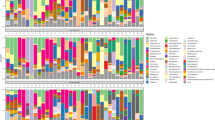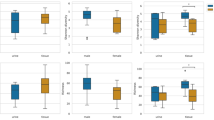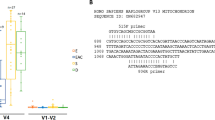Abstract
Objectives
To prospectively examine the changes in microbiota within the urinary tract after transrectal prostate biopsy.
Materials and methods
Data, urine, and fecal samples prospectively collected from 30 patients before and after transrectal biopsy of the prostate. DNA was extracted from urine collected after a prostate massage before and after prostate biopsy, and from fecal samples collected before the biopsy. We sequenced DNA using the bacterial 16S rRNA high-throughput next-generation sequencing and analyzed changes in microbial profiles for taxonomy comparison between samples.
Results
Pre-biopsy urinary microbial profiles contained Lactobacillus and Staphylococcus bacteria. Post-biopsy urinary microbial profiles included lower levels of Lactobacillus and higher levels of Prevotella bacteria. Bacteroides bacteria were predominant in fecal samples. We identified two clustering patterns containing both pre- and post-biopsy urine samples. Cluster 1 had a urine cluster pattern that was distinct from fecal, whereas cluster 2 was similar to fecal. We observed two different modes of microbial changes, 11 patients had both of their urine (pre and post) samples associated with a particular cluster group, whereas others (n = 15) had movement between clusters 1 and 2 following the biopsy procedure. Four patient’s post-biopsy urine microbial profiles clustered very tightly to the fecal microbial profile.
Conclusions
We describe two models of change in the urinary tract microbiota after prostate biopsy using 16S RNA gene analysis. Further research to determine what controls changes in the urinary microbiota after prostate biopsy can help us understand why some patients are more susceptible to develop post-biopsy infections.
This is a preview of subscription content, access via your institution
Access options
Subscribe to this journal
Receive 4 print issues and online access
$259.00 per year
only $64.75 per issue
Buy this article
- Purchase on Springer Link
- Instant access to full article PDF
Prices may be subject to local taxes which are calculated during checkout



Similar content being viewed by others
References
Liss MA, Chang A, Santos R, Nakama-Peeples A, Peterson EM, Osann K, et al. Prevalence and significance of fluoroquinolone resistant Escherichia coli in patients undergoing transrectal ultrasound guided prostate needle biopsy. J Urol. 2011;185:1283–8.
Zani EL, Clark OA, Rodrigues Netto N, Jr. Antibiotic prophylaxis for transrectal prostate biopsy. Cochrane Database Syst Rev. 2011;CD006576.
Nam RK, Saskin R, Lee Y, Liu Y, Law C, Klotz LH, et al. Increasing hospital admission rates for urological complications after transrectal ultrasound guided prostate biopsy. J Urol. 2010;183:963–8.
Wolfe AJ, Toh E, Shibata N, Rong R, Kenton K, Fitzgerald M, et al. Evidence of uncultivated bacteria in the adult female bladder. J Clin Microbiol. 2012;50:1376–83.
Brubaker L, Nager CW, Richter HE, Visco A, Nygaard I, Barber MD, et al. Urinary bacteria in adult women with urgency urinary incontinence. Int Urogynecol J. 2014;25:1179–84.
Hilt EE, McKinley K, Pearce MM, Rosenfeld AB, Zilliox MJ, Mueller ER, et al. Urine is not sterile: use of enhanced urine culture techniques to detect resident bacterial flora in the adult female bladder. J Clin Microbiol. 2014;52:871–6.
Khasriya R, Sathiananthamoorthy S, Ismail S, Kelsey M, Wilson M, Rohn JL, et al. Spectrum of bacterial colonization associated with urothelial cells from patients with chronic lower urinary tract symptoms. J Clin Microbiol. 2013;51:2054–62.
Riesenfeld CS, Schloss PD, Handelsman J. Metagenomics: genomic analysis of microbial communities. Annu Rev Genet. 2004;38:525–52.
Wu GD, Chen J, Hoffmann C, Bittinger K, Chen YY, Keilbaugh SA, et al. Linking long-term dietary patterns with gut microbial enterotypes. Science. 2011;334:105–8.
Caporaso JG, Kuczynski J, Stombaugh J, Bittinger K, Bushman FD, Costello EK, et al. QIIME allows analysis of high-throughput community sequencing data. Nat Methods. 2010;7:335–6.
Shrestha E, White JR, Yu SH, Kulac I, Ertunc O, De Marzo AM, et al. Profiling the urinary microbiome in men with positive versus negative biopsies for prostate cancer. J Urol. 2017;199:161–71.
Mohanty NK, Jolly BB. Incidence of anaerobic bacterial infection following transurethral instrumentation. Indian J Pathol Microbiol. 1996;39:33–6.
Shivde SR, Cooke RP, O’Neill WA, Cowie AG, Lawrence WT, Watson GM. Trimethoprim versus gentamicin for the prevention of bacteriuria following transrectal biopsy of the prostate–do patients need additional anaerobic cover? Urol Int. 2002;69:106–10.
Duplessis CA, Bavaro M, Simons MP, Marguet C, Santomauro M, Auge B, et al. Rectal cultures before transrectal ultrasound-guided prostate biopsy reduce post-prostatic biopsy infection rates. Urology. 2012;79:556–61.
Evaldson G, Heimdahl A, Kager L, Nord CE. The normal human anaerobic microflora. Scand J Infect Dis Suppl. 1982;35:9–15.
Lloyd AL, Smith SN, Eaton KA, Mobley HL. Uropathogenic Escherichia coli suppresses the host inflammatory response via pathogenicity island genes sisA and sisB. Infect Immun. 2009;77:5322–33.
Gorvitovskaia A, Holmes SP, Huse SM. Interpreting Prevotella and Bacteroides as biomarkers of diet and lifestyle. Microbiome. 2016;4:15.
Yu H, Meng H, Zhou F, Ni X, Shen S, Das UN. Urinary microbiota in patients with prostate cancer and benign prostatic hyperplasia. Arch Med Sci. 2015;11:385–94.
Acknowledgements
This work was supported by Southern Illinois University research grant.
Author information
Authors and Affiliations
Contributions
SA: Study design, data collection and interpretation, manuscript writing, and supervision. Ahmed El-Zawahry MD, PhD: Study design, data collection and interpretation, manuscript writing. Danuta Dynda MD: Regulatory coordination and patient consenting, data collection and analysis. Kevin McVary MD: Data analysis, critical revision of the paper, and supervision. Mallory Karr: Data analysis and interpretation, manuscript writing. Andrea Braundmeier-Fleming PhD: Study design, data analysis and interpretation, manuscript writing, and supervision.
Corresponding author
Ethics declarations
Conflict of interest
The authors declare that they have no conflict of interest.
Additional information
Publisher’s note: Springer Nature remains neutral with regard to jurisdictional claims in published maps and institutional affiliations.
Rights and permissions
About this article
Cite this article
Alanee, S., El-Zawahry, A., Dynda, D. et al. Prospective examination of the changes in the urinary microbiome induced by transrectal biopsy of the prostate using 16S rRNA gene analysis. Prostate Cancer Prostatic Dis 22, 446–452 (2019). https://doi.org/10.1038/s41391-018-0120-3
Received:
Revised:
Accepted:
Published:
Issue Date:
DOI: https://doi.org/10.1038/s41391-018-0120-3
This article is cited by
-
Urinary microbiota and prostatic diseases: the key for the lock? A systematic review
Prostate Cancer and Prostatic Diseases (2023)
-
Serine and one-carbon metabolisms bring new therapeutic venues in prostate cancer
Discover Oncology (2021)
-
Human microbiome and prostate cancer development: current insights into the prevention and treatment
Frontiers of Medicine (2021)
-
The urinary microbiome shows different bacterial genera in renal transplant recipients and non-transplant patients at time of acute kidney injury – a pilot study
BMC Nephrology (2020)



